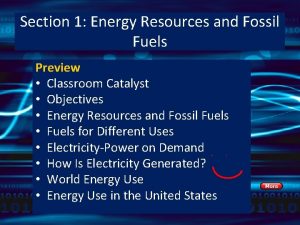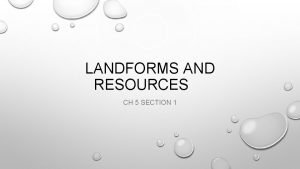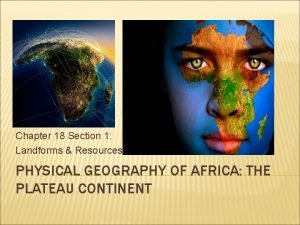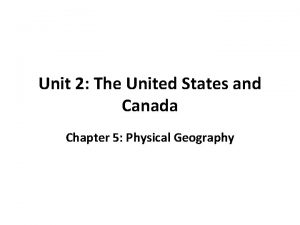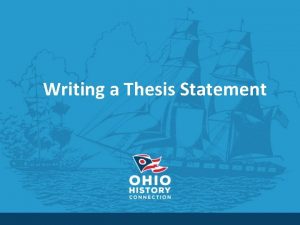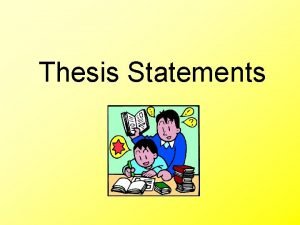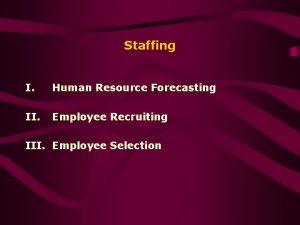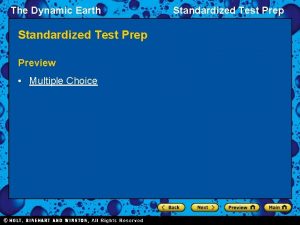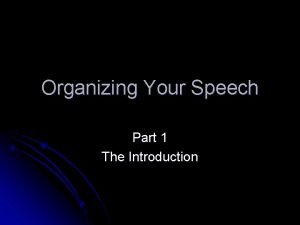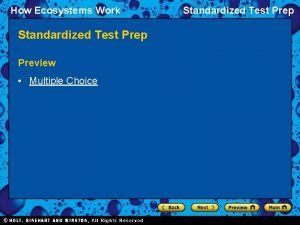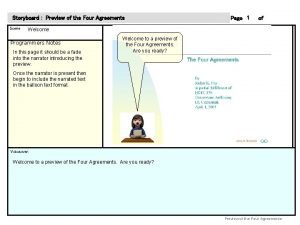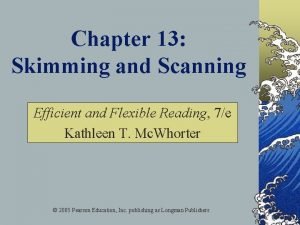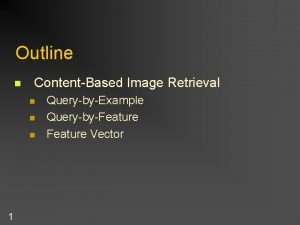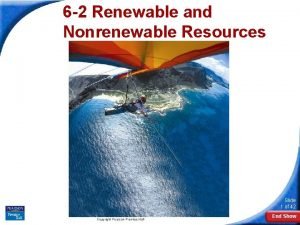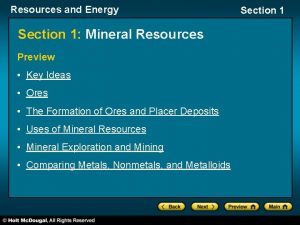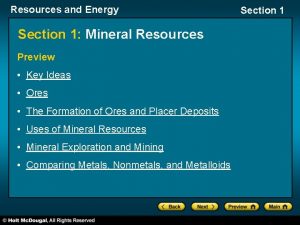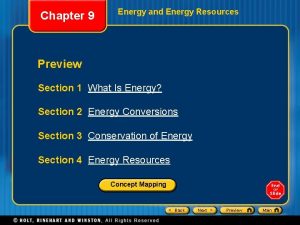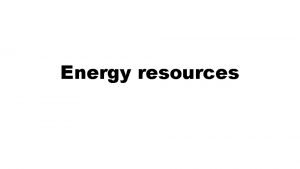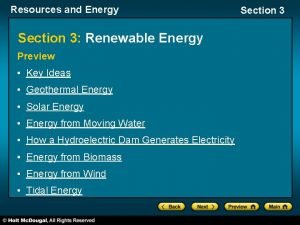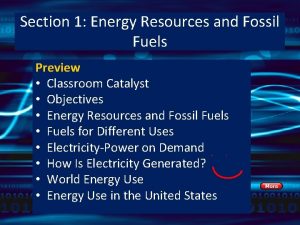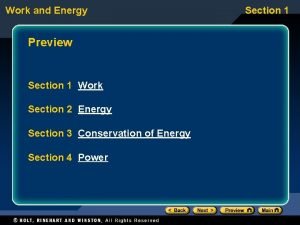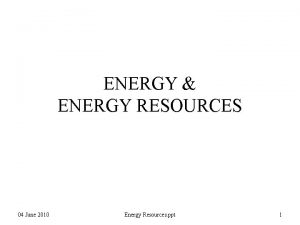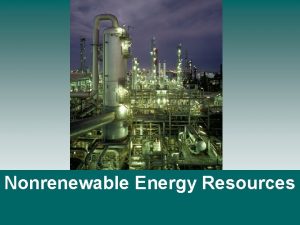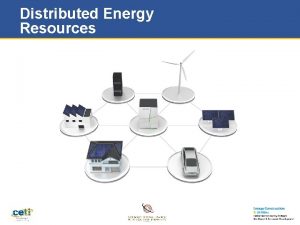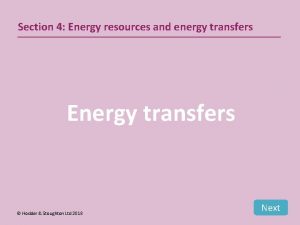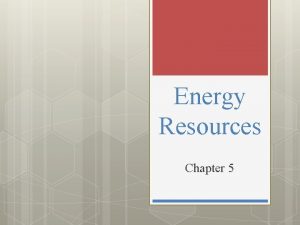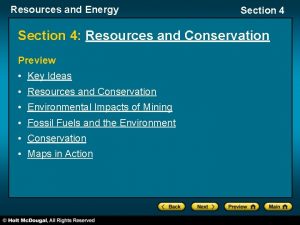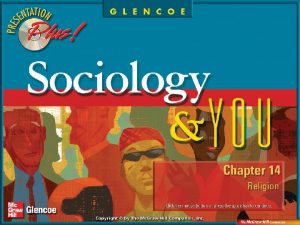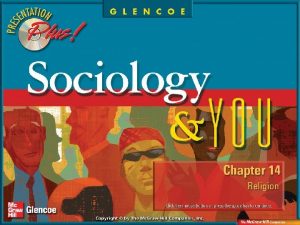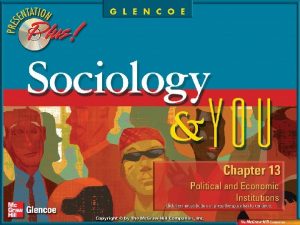Chapter 9 Energy and Energy Resources Preview Section














































- Slides: 46

Chapter 9 Energy and Energy Resources Preview Section 1 What Is Energy? Section 2 Energy Conversions Section 3 Conservation of Energy Section 4 Energy Resources Concept Mapping < Back Next > Preview Main

Chapter 9 Section 1 What Is Energy? Objectives • Explain the relationship between energy and work. • Compare kinetic energy and potential energy. • Describe the different forms of energy. < Back Next > Preview Main

Chapter 9 Section 1 What Is Energy? Energy and Work: Working Together • Energy is the ability to do work. • Work is done when a force causes an object to move in the direction of the force. Work is a transfer of energy. • Energy and work are expressed in units of joules (J). < Back Next > Preview Main

Chapter 9 Section 1 What Is Energy? < Back Next > Preview Main

Chapter 9 Section 1 What Is Energy? Kinetic Energy • Kinetic energy is the energy of motion. All moving objects have kinetic energy. • Kinetic Energy Depends on Mass and Speed If you know an object’s mass (m) and its speed (v), you can calculate the object’s kinetic energy with the following equation: mv 2 kinetic energy 2 < Back Next > Preview Main

Chapter 9 Section 1 What Is Energy? Kinetic Energy Click below to watch the Visual Concept < Back Next > Preview Main

Chapter 9 Section 1 What Is Energy? Potential Energy • Potential energy is the energy an object has because of its position. • Gravitational Potential Energy The amount of gravitational potential energy that an object has depends on its weight and its height. < Back Next > Preview Main

Chapter 9 Section 1 What Is Energy? Potential Energy, continued • Calculating Gravitational Potential Energy The equation to find gravitational potential energy is: gravitational potential energy weight height • Gravitational potential energy is equal to the amount of work done on an object to lift it a certain height. < Back Next > Preview Main

Chapter 9 Section 1 What Is Energy? Potential Energy, continued • Height Above What? When you find out an object’s gravitational potential energy, the “ground” that you measure the object’s height from depends on where it is. • The height you use in calculating gravitational potential energy is a measure of how far an object has to fall. < Back Next > Preview Main

Chapter 9 Section 1 What Is Energy? Mechanical Energy • Mechanical energy is the total energy of motion and position of an object. Both kinetic energy and potential energy are kinds of mechanical energy. • The equation to find mechanical energy is: mechanical energy potential energy kinetic energy < Back Next > Preview Main

Chapter 9 Section 1 What Is Energy? Mechanical Energy, continued • The mechanical energy of an object remains the same unless it transfers some energy to another object. • But even if the mechanical energy of an object stays the same, the potential energy or kinetic energy can increase or decrease. < Back Next > Preview Main

Chapter 9 Section 1 What Is Energy? Other Forms of Energy • Thermal Energy is all of the kinetic energy due to random motion of the particles that make up an object. • All matter is made up of particles that are always in random motion. So, all matter has thermal energy. • Thermal energy increases as temperature increases and increases as the number of particles increases. < Back Next > Preview Main

Chapter 9 Section 1 What Is Energy? < Back Next > Preview Main

Chapter 9 Section 1 What Is Energy? Other Forms of Energy, continued • Chemical Energy is the energy of a chemical compound that changes as its atoms are rearranged. • Chemical energy is a form of potential energy because it depends on the position and arrangement of the atoms in a compound. • The energy in food is chemical energy. < Back Next > Preview Main

Chapter 9 Section 1 What Is Energy? Other Forms of Energy, continued • Electrical Energy is the energy of moving electrons. Electrical energy can be thought of as potential energy that is used when you plug in an electrical appliance and use it. • Sound Energy is caused by an object’s vibrations. The object’s vibrations transmit some kinetic energy to the air particles, which also vibrate. These vibrations transmit sound energy. < Back Next > Preview Main

Chapter 9 Section 1 What Is Energy? Other Forms of Energy, continued • Light Energy is produced by the vibrations of electrically charged particles. • Nuclear Energy is energy that comes from changes in the nucleus of an atom. Nuclear energy can be produced when nuclei are joined in a fusion reaction or when a nucleus is split apart in a fission reaction. < Back Next > Preview Main

Chapter 9 Section 2 Energy Conversions Objectives • Describe an energy conversion. • Give examples of energy conversions for the different forms of energy. • Explain how energy conversions make energy useful. • Explain the role of machines in energy conversions. < Back Next > Preview Main

Chapter 9 Section 2 Energy Conversions Kinetic Energy and Potential Energy • An energy conversion is a change from one form of energy to another. Any form of energy can change into any other form of energy. • As the skateboarder on the next slide travels up and down the half-pipe, his energy changes back and forth between kinetic energy and potential energy. < Back Next > Preview Main

Chapter 9 Section 2 Energy Conversions < Back Next > Preview Main

Chapter 9 Section 2 Energy Conversions Kinetic Energy and Potential Energy, continued • Elastic Potential Energy Stretching a rubber band stores elastic potential energy in the rubber band. • When you let the rubber band go, it goes back to its original shape. It releases its stored-up potential energy as it does so. < Back Next > Preview Main

Chapter 9 Section 2 Energy Conversions Involving Chemical Energy • Chemical energy is stored in the food you eat. Your body uses this chemical energy to function. • Energy Conversion in Plants The chemical energy in the food you eat comes from the sun’s energy. Plants use photosynthesis to convert light energy into chemical energy, as shown on the next slide. < Back Next > Preview Main

Chapter 9 Section 2 Energy Conversions < Back Next > Preview Main

Chapter 9 Section 2 Energy Conversions Involving Chemical Energy, continued • The Process Continues Plants change light energy into chemical energy. The chemical energy in the food you eat is changed into another kind of chemical energy that your body can use. • Your body then uses that energy to give you kinetic energy that you use in everything you do. < Back Next > Preview Main

Chapter 9 Section 2 Energy Conversions Why Energy Conversions Are Important • Energy conversions are needed for everything we do. Heating our homes, getting energy from a meal, and many other things use energy conversions. • Machines, such as a hair dryer, help harness energy and make that energy work for you. < Back Next > Preview Main

Chapter 9 Section 2 Energy Conversions Why Energy Conversions Are Important, continued • Conversions Involving Electrical Energy Some common energy conversions that involve electrical energy are shown in the table below. Alarm clock electrical energy light and sound energy Battery chemical energy electrical energy Light bulb electrical energy light and thermal energy Blender electrical energy kinetic and sound energy < Back Next > Preview Main

Chapter 9 Section 2 Energy Conversions Energy and Machines • A machine can make work easier by changing the size or direction (or both) of the force needed to do the work. Some machines allow you to use less force over a greater distance to do the same amount of work. • Machines as Energy Converters Some machines help you use energy by converting it into the form of energy that you need. < Back Next > Preview Main

Chapter 9 Section 2 Energy Conversions < Back Next > Preview Main

Chapter 9 Section 3 Conservation of Energy Objectives • Explain how energy is conserved within a closed system. • Explain the law of conservation of energy. • Give examples of how thermal energy is always a result of energy conversion. • Explain why perpetual motion is impossible. < Back Next > Preview Main

Chapter 9 Section 3 Conservation of Energy Where Does the Energy Go? • Friction is a force that oppose motion between two surfaces that are touching. • For a roller coaster car to move, energy must be used to overcome the friction between the car’s wheels and the track. • As a result, not all of the car’s potential energy changes into kinetic energy and not all of the car’s kinetic energy changes back into potential energy. < Back Next > Preview Main

Chapter 9 Section 3 Conservation of Energy < Back Next > Preview Main

Chapter 9 Section 3 Conservation of Energy Is Conserved Within a Closed System • A closed system is a group of objects that transfer energy only to each other. • The Law of Conservation of Energy states that energy cannot be created or destroyed. • Energy can be converted from one form to another. But all of the different forms of energy in a system always add up to the same total amount of energy. < Back Next > Preview Main

Chapter 9 Section 3 Conservation of Energy Is Conserved Within a Closed System, continued • The image below shows energy conservation in a light bulb. < Back Next > Preview Main

Chapter 9 Section 3 Conservation of Energy No Conversion Without Thermal Energy • Any time one form of energy is converted into another form, some of the original energy always gets converted into thermal energy. • The thermal energy due to friction that results from energy conversions is not usually useful energy. < Back Next > Preview Main

Chapter 9 Section 3 Conservation of Energy No Conversion Without Thermal Energy, continued • Perpetual Motion? No Way! A perpetual motion machine is a machine that would run forever without any additional energy. • But perpetual motion machines are impossible because some waste thermal energy always results from energy conversions. < Back Next > Preview Main

Chapter 9 Section 3 Conservation of Energy No Conversion Without Thermal Energy, continued • Making Conversions Efficient Some systems transform energy with less loss of heat than others do. Such systems are more efficient than others are. • Improving the efficiency of machines is important because greater efficiency results in less waste. If less energy is wasted, less energy is needed to operate a machine. < Back Next > Preview Main

Chapter 9 Section 4 Energy Resources Objectives • Name several energy resources. • Explain how the sun is the source of most energy on Earth. • Evaluate the advantages and disadvantages of using various energy resources. < Back Next > Preview Main

Chapter 9 Section 4 Energy Resources Nonrenewable Resources • Nonrenewable resources cannot be replaced or are replaced much more slowly than they are used. • Fossil fuels are nonrenewable energy resources that formed from the remains of organisms that lived long ago. Oil, natural gas, and coal are the most common fossil fuels. < Back Next > Preview Main

Chapter 9 Section 4 Energy Resources < Back Next > Preview Main

Chapter 9 Section 4 Energy Resources Nonrenewable Resources, continued • Uses of Fossil Fuels All fossil fuels contain stored energy from the sun, which can be converted into other kinds of energy. • Burning coal is a common way to generate electrical energy. Petroleum is used to make gasoline, wax, and plastics. Natural gas is often used in home heating. < Back Next > Preview Main

Chapter 9 Section 4 Energy Resources Nonrenewable Resources, continued • Electrical Energy from Fossil Fuels Electric generators convert the chemical energy in fossil fuels into electrical energy by the process shown below. < Back Next > Preview Main

Chapter 9 Section 4 Energy Resources Nonrenewable Resources, continued • Nuclear Energy Another way to generate electrical energy is to use nuclear energy. • In a process called nuclear fission, the nucleus of a radioactive atom is split into two smaller nuclei, which releases nuclear energy. • Because the supply of radioactive elements is limited, nuclear energy is a nonrenewable resource. < Back Next > Preview Main

Chapter 9 Section 4 Energy Resources Renewable Resources • Renewable resources are naturally replaced more quickly than they are used. • Solar Energy Sunlight can be changed into electrical energy through solar cells. • Solar cells can be used in devices such as calculators. They can also be placed on the roof of a house to provide electrical energy. < Back Next > Preview Main

Chapter 9 Section 4 Energy Resources Renewable Resources, continued • Energy from Water The potential energy of water in a reservoir can be changed into kinetic energy as the water flows through a dam. • In a hydroelectric dam, falling water turns turbines. The turbines are connected to a generator that changes kinetic energy into electrical energy. < Back Next > Preview Main

Chapter 9 Section 4 Energy Resources Renewable Resources, continued • Wind Energy The kinetic energy of wind can turn the blades of a windmill or a wind turbine. • A wind turbine changes the kinetic energy of the air into electrical energy by turning a generator. < Back Next > Preview Main

Chapter 9 Section 4 Energy Resources Renewable Resources, continued • Geothermal Energy is thermal energy caused by the heating of Earth’s crust. This energy can be converted into electrical energy at geothermal power plants. • Biomass is organic matter, such as plants, wood, and waste, that can be burned to release energy. Some countries depend on biomass for energy. < Back Next > Preview Main

Chapter 9 Section 4 Energy Resources The Two Sides to Energy Resources • All energy resources have advantages and disadvantages. Many factors determine when one energy source is a better choice than another. • Choosing the Right Energy Source Energy planning in all parts of the world requires careful consideration of energy needs and the availability and responsible use of resources. < Back Next > Preview Main
 Deposit
Deposit Chapter 24 the land where continents collided
Chapter 24 the land where continents collided What is the most distinctive landform in southwest asia
What is the most distinctive landform in southwest asia Landforms and resources
Landforms and resources China population density
China population density Chapter 18 section 1 landforms and resources
Chapter 18 section 1 landforms and resources Unit 2 the united states and canada worksheet answers
Unit 2 the united states and canada worksheet answers Thesis example
Thesis example Summary thesis statement
Summary thesis statement Thesis and preview statement example
Thesis and preview statement example Realistic job preview advantages and disadvantages
Realistic job preview advantages and disadvantages Review and preview
Review and preview Benefits of hr forecasting
Benefits of hr forecasting The transformation process
The transformation process Fixed and variable resources examples
Fixed and variable resources examples Section 1 water resources
Section 1 water resources Test prep preview
Test prep preview Test prep preview
Test prep preview Test prep preview
Test prep preview Test prep preview
Test prep preview Sccm technical preview
Sccm technical preview Preview statement speech example
Preview statement speech example Test prep preview
Test prep preview Nnn preview
Nnn preview The selection preview
The selection preview Test prep preview
Test prep preview The four agreements preview
The four agreements preview Test prep preview
Test prep preview Line between pada perintah column digunakan untuk membuat
Line between pada perintah column digunakan untuk membuat Test prep preview
Test prep preview Skimming newspaper
Skimming newspaper 1984 book preview
1984 book preview Yandex film ru
Yandex film ru Nút lệnh print preview nằm ở đâu
Nút lệnh print preview nằm ở đâu Tams preview day
Tams preview day Disadvantages of realistic job preview
Disadvantages of realistic job preview Preview of main points
Preview of main points Preview speech
Preview speech Example of verbal intercultural communication
Example of verbal intercultural communication Nnn image preview
Nnn image preview Cara menampilkan preview file di windows 10
Cara menampilkan preview file di windows 10 Chemical potential energy images
Chemical potential energy images Renewable vs nonrenewable resources worksheet
Renewable vs nonrenewable resources worksheet Section 4 review physical science
Section 4 review physical science Chapter 12 nonrenewable energy resources
Chapter 12 nonrenewable energy resources Landforms in moscow
Landforms in moscow Section 6-2 renewable and nonrenewable resources
Section 6-2 renewable and nonrenewable resources
